Albert’s Lyrebird (Menura alberti) Rare
Evidence from DNA studies show lyrebirds, scrub-birds, treecreepers and bowerbirds, all of which evolved on the Australian landmass, to be the most ancient of the world’s songbirds. So, the world’s songbirds had their origins in Australia many millions of years ago.
Lyrebirds and scrub-birds are the oldest line of songbirds still surviving.
Lyrebirds are renowned mimics, not only mimicking other birds but also human-produced sounds such as car tyres on gravel, alarms and chain saws. |
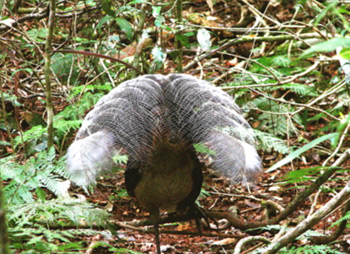 Photo: Kimbal Curtis Photo: Kimbal Curtis |
Rufous Scrub-bird (Atrichornis rufescens) Vulnerable
As noted above, scrub-birds and lyrebirds are the oldest line of songbirds in the world. As for lyrebirds, there are just two species of scrub-bird, Rufous and Noisy, with the latter occurring only in the southwest corner of Western Australia. The scrub-birds are so different from other birds that, like lyrebirds, they are placed in their own family. So, the only two species in the family are separated by 3500 kilometres! |
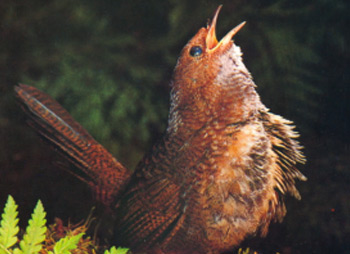 Photo: Michael Morcombe
Photo: Michael Morcombe |
Masked Mountain Frog (Kyarranus loveridgei) Rare
Masked Mountain Frog or Loveridge’s Frog is found only in high-altitude rainforests (above 750 metres) on the McPherson Range in southeast Queensland and across the border in far northeast New South Wales. A rare, relatively small frog, it breeds its young in flask-shaped burrows in soft soil or in mossy cavities beside streams.
Fossils of Kyarranus have been found in deposits at Riversleigh, indicating their ancient origins and widespread occurrence when rainforests covered the continent. |
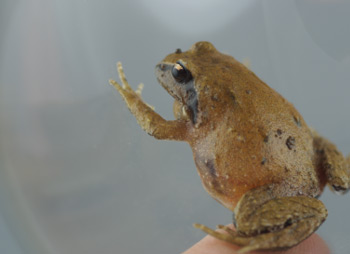 Photo: Aila Keto & Keith Scott Photo: Aila Keto & Keith Scott |
Marsupial or Hip-pocket Frog (Assa darlingtoni) Rare
The Marsupial Frog is a rare species found only in high-altitude rainforests on the McPherson Range in southeast Queensland and the adjoining Border Ranges area in New South Wales. It is almost unique in raising its young in ‘pockets’ on its flanks. Its nearest relative is in South America, indicating its Gondwanan origin.
It is not only rare among frogs for the parents to look after their young, but is also rare within the animal kingdom for the male to have sole responsibility for parenting. |
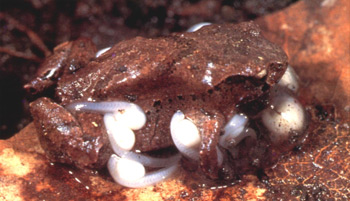 © Harry Ehmann
© Harry Ehmann |
Eucryphia jinksii (Cunoniaceae) Springbrook Pinkwood Endangered
Endangered. This very rare tree occurs at just a few locations in rainforest at Springbrook and across the border in Numinbah Nature Reserve. The story of Eucryphia is extraordinary. The genus was previously known from 5 species, two endemic to Chile and 3 endemic to temperate rainforests in southern Australia. This distribution demonstrated the ancient Gondwanan origins of the genus. Nearly 40 years ago, a new species was recognised, amazingly, in tropical North Queensland. It was, however, not described until 1996. Botanists Paul Forster and Bernie Hyland formally described not only the North Queensland species, Eucryphia wilkiei, but also the Springbrook species discovered in 1994 by Springbrook botanist, David Jinks.
Eucryphia had been regarded as a genus of temperate forests. Hence, the discoveries in tropical and subtropical forests were more than surprising. Forster and Hyland note that the forest types in which these two species occur are floristically similar to those of southern types and that weather conditions are also similar.
Eucryphia jinksii and Eucryphia wilkiei must be regarded as relict species that are “persisting in narrow ecological niches in otherwise unsuitable climatic zones”. |
|
Ochrosia moorei (Apocynaceae) Ochrosia Endangered.
Ochrosia moorei is a highly restricted plant occurring only on the north-eastern section of the Mt Warning shield volcano remnants.
|
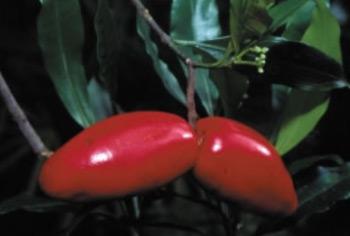 © © Glenn Leiper |

© Glenn Leiper
|
Euphrasia bella (Scrophulariaceae) Lamington Eyebright Endangered
Euphrasia bella is an erect, perennial herb growing on exposed rock faces. It has a restricted distribution occurring on the McPherson Range, including Springbrook, and the Border Ranges in New South Wales. |
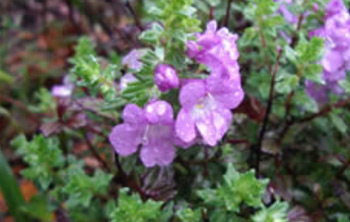
Photo: Wayne Abbot |
Sarchochilus hartmannii Cliff Orchid (Orchidaceae) Vulnerable
The Cliff Orchid occurs predominantly in the McPherson Range/Border Ranges area.
|
 Cliff Orchid, Sarcochilus hartmannii.Photo: Aila Keto |
|
Helicia ferruginea Rusty Helicia (Proteaceae) Vulnerable
Rusty Helicia is largely restricted to remnants of the Tweed Shield volcano.
Proteales is a key basal angiosperm order with Gondwanan origins. It is represented in Australia by the Proteaceae which has recently been recognised as basal to the two Northern Hemisphere families. The Proteaceae have the most extensive fossil record in the Southern Hemisphere of any taxonomic group. There are 4-6 subfamilies and the greatest diversity of subfamilies occurs in Australia, particularly in Queensland which also has the greatest diversity in Australia at the generic level.
The Springbrook region contains 22 species in 14 genera from three subfamilies and nine of the 15 tribes of Proteaceae |
|
Symplocos baeuerlenii (Symplocaceae) Small-leaved Hazelwood
Vulnerable.
This small tree or shrub occurs only at higher altitudes in on remnants of the Mt Warning shield volcano. From our experience, wherever you find this plant at Springbrook, you will almost invariably find Triunia youngiana and Psychotria simmondsiana. |
|
Ardisia bakeri (Myrsinaceae) Ardisia Rare
Classified as ‘near threatened’ (rare). Found only on the Mt Warning shield volcano remnants, A. bakeri is a shrub to small tree with zig-zag branches bearing red fruits. It is found in higher parts of Springbrook and at the sites where it does occur it can be quite common.
Early records include rainforest gullies in the Tweed Valley but it now appears to be largely restricted to Springbrook Plateau.
|
|
Cupaniopsis newmanii Long-leaved Tuckeroo (Sapindaceae) Rare
Long-leaved Tuckeroo occurs mainly around the McPherson Rang/Border Ranges. New growth is bright orange.
Read More HERE |
|

